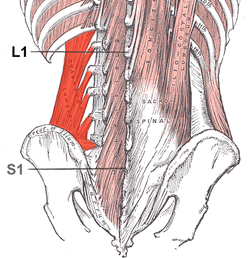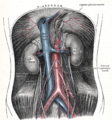- Quadratus lumborum muscle
-
Quadratus lumborum muscle The relations of the kidneys from behind. (Quadratus lumborum visible at lower left.) Deep muscles of the back. (Quadratus lumborum visible at bottom left.) Latin musculus quadratus lumborum Gray's subject #118 420 Origin iliac crest and iliolumbar ligament Insertion Last rib and transverse processes of lumbar vertebrae Artery Lumbar arteries, lumbar branch of iliolumbar artery Nerve The twelfth thoracic and first through fourth lumbar nerves Actions Alone, lateral flexion of vertebral column; Together, depression of thoracic rib cage The Quadratus lumborum is irregular and quadrilateral in shape, and broader below than above.
Contents
Origin and insertion
It arises by aponeurotic fibers from the iliolumbar ligament and the adjacent portion of the iliac crest for about 5 cm., and is inserted into the lower border of the last rib for about half its length, and by four small tendons into the apices of the transverse processes of the upper four lumbar vertebrae.
Occasionally a second portion of this muscle is found in front of the preceding. It arises from the upper borders of the transverse processes of the lower three or four lumbar vertebræ, and is inserted into the lower margin of the last rib.
Relations
Anterior to the Quadratus lumborum are the colon, the kidney, the Psoas major and (if present) psoas minor, and the diaphragm; between the fascia and the muscle are the twelfth thoracic, ilioinguinal, and iliohypogastric nerves.
Variations
The number of attachments to the vertebræ and the extent of its attachment to the last rib vary.
Actions
The quadratus lumborum can perform four actions:
- Lateral flexion of vertebral column, with ipsilateral contraction
- Extension of lumbar vertebral column, with bilateral contraction
- Fixes the 12th rib during forced expiration
- Levates ilium, with ipsilateral contraction
Indications
The quadratus lumborum, or QL, is a common source of lower back pain.[1] Because the QL connects the pelvis to the spine and is therefore capable of extending the lower back when contracting bilaterally, the two QLs pick up the slack, as it were, when the lower fibers of the erector spinae are weak or inhibited (as they often are in the case of habitual seated computer use and/or the use of a lower back support in a chair). Given their comparable mechanical disadvantage, constant contraction while seated can overuse the QLs, resulting in muscle fatigue.[2] A constantly contracted QL, like any other muscle, will experience decreased bloodflow, and, in time, adhesions in the muscle and fascia may develop, the end point of which is muscle spasm.
This chain of events can be and often is accelerated by kyphosis which is invariably accompanied by rounded shoulders, both of which place greater stress on the QLs by shifting body weight forward, forcing the erector spinae, QLs, multifidi, and especially the levator scapulae to work harder in both seated and standing positions to maintain an erect torso and neck. The experience of "productive pain" or pleasure by a patient upon palpation of the QL is indicative of such a condition.
While stretching and strengthening the QL are indicated for unilateral lower back pain, heat/ice applications as well as massage and other myofascial therapies should be considered as part of any comprehensive rehabilitation regimen.[3]
Additional images
References
External links
- LUC ql
- -1234501552 at GPnotebook
- quadratus+lumborum+muscle at eMedicine Dictionary
- Atlas of anatomy at UMich abdo_wall70 - "Posterior Abdominal Wall, Dissection, Anterior View"
- Stretching the Quadratus Lumborum
- Massaging the Quadratus Lumborum
This article was originally based on an entry from a public domain edition of Gray's Anatomy. As such, some of the information contained within it may be outdated.
List of muscles of abdominopelvic cavity (TA A04.5, GA 4.408) Abdomen/
wallAnterior/
lateralMuscleFasciaFascia/abdominal fascia: panniculus adiposus (Fascia of Camper) · stratum membranosum (Fascia of Scarpa) · Transversalis fascia (Interfoveolar ligament)
Linea alba · Linea semilunaris · Inguinal triangle
Inguinal canal (Deep inguinal ring, Superficial inguinal ring, Intercrural fibers, Crura of superficial inguinal ring)
Inguinal ligament (Pectineal ligament, Lacunar ligament, Reflected ligament)PosteriorMuscleFasciaPelvis MuscleFasciafascia/pelvic fascia visceral (Rectovaginal fascia, Rectoprostatic fascia) · parietal (Obturator fascia/Tendinous arch, Piriformis fascia)
floor/diaphragm: Superior fascia of pelvic diaphragm (Pubovesical ligament, Puboprostatic ligament) · Inferior fascia of pelvic diaphragm
Anococcygeal bodyCategories:- Muscles of the torso
Wikimedia Foundation. 2010.








